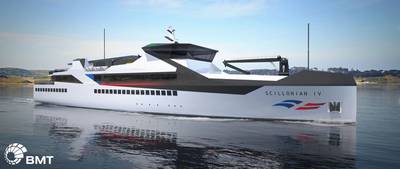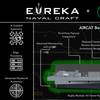VIDEO: Inside the New Ferry Pair for Isles of Scilly Steamship
As the bid package goes out to shipyards, Sylvain Julien, Director, Naval Architecture, Specialized Ship Design, BMT, discusses how local stakeholder demands and futureproofing shipboard technology drove the design of a pair of ferries for the Isles of Scilly Steamship Company.
The Isles of Scilly Steamship Company Ltd. has provided a lifeline to the Isles of Scilly since it was formed in 1920. When attention turned to designing a pair of new vessels – one passenger and one cargo – to service the island, it teamed up with BMT to deliver a design that was not only aesthetically pleasing, but also able to carry more passengers and more cargo, faster but with reduced fuel consumption.
The new 72-meter passenger ferry is designed to carry 600 passengers over three decks with a contemporary seating arrangement, onboard coffee shop and retail area. This vessel has a designed service speed of 18 knots, effectively cutting the journey time by 20% as compared to the current vessel servicing the route. It is outfitted with an anti-roll stabilization system for passenger comfort and a hybrid propulsion system to help reduce emissions. The passenger vessel was constrained in its dimensions by the size of the pilot gate and the water depths available at the harbor, so BMT had to better utilize the space available and strike a balancing act between the space requirement of each of the vessel’s functions.
“The first step of our work was to develop a set of requirements based on the operational needs, which took the form of discussions with the crew and shore team,” said Julien. “We also surveyed the vessel and port infrastructure, to ensure that we had a good picture of their needs.”
The BMT team also reviewed and incorporated the wishes of the local community. “The Isles of Scilly Steamship operates a lifeline service between Penzance and the Isles of Scilly, and they benefit from a very strong relationship with the local community,” Julien said. “It's really important for them that the community's concerns and wishes are addressed throughout this project.”
The vessel being replaced, Scillonian Three, was built in 1977 and is an iconic vessel in the region. Julien and his team knew it had to offer an improved passenger experience and a forward-looking vision, technologically. But also, too, the fundamentals of vessel operation were a top priority. “For example, this may be ensuring that the design allows for different cargo to be loaded and unloaded in a specific order, to mesh seamlessly with the shore infrastructure. I think for them, this is a once in a lifetime fleet change, as they are changing all of their vessels.”
One of the key aspects of the design is the introduction of a completely different passenger space, compared to the existing vessel. The design is much more modern, to allow for an increased passenger number, but also to provide improved external views.
In addition to the passenger vessel, the BMT team were asked to design a 45-meter cargo vessel to replace the Gry Maritha. The new ship will have an increased cargo capacity, including more space for chilled and frozen goods, a crane that can lift eight tons and a lounge for up to 12 passengers. This cargo ferry will be designed for a 12-knot service speed, allowing for significantly faster journey times between St Mary’s and the off-islands, a 50% increase in cargo capacity, and will have a reduced fuel consumption of 55%.
“We worked with the Isles of Scilly in a very similar way to support the new development,” Julien said. “The focus here, of course, was firmly on the logistics operation. Unlike the passenger vessel, which only operates part of the year, the cargo vessel operates all year round and is the only freight service to the Isles of Scilly. Although less glamorous than the passenger vessel, both the community and the Isles of Scilly Steamship have high expectations for these vessels. It is their lifeline.”
Flexibility was the keyword in designing the cargo vessel, as cargo needs and types vary widely to support the summer tourism season, as compared to the colder months during the ‘off-season’ when it primarily serves local residents.
As the cargo vessel, too, was limited in its dimensions, BMT worked on a modular cargo layout, to handle the variation of cargo type during the year, including an increased capacity for frozen cargo without compromising the overall layout.
As for propulsion, on both vessels the environment, flexibility and ‘future-proofing’ the vessel were drivers, and a hybrid diesel electric configuration with ample battery capacity was the choice.
“In practice, this takes a form of a mechanical propulsion system,” Julien said. “Here you're talking about the traditional shaft and propulsion and diesel engine. This system is then supported by an electric motor that can also act as a generator, and this electric side is then coupled to an energy storage solution, batteries. The system mix is the best use of each part of the system, to reduce fuel consumption overall.”
Importantly, it allows the vessels to be emissions free while at berth, relying on battery energy storage for power.
Second, and equally important, is future-proofing the vessel so that it is suitable for upcoming upgrades as the technology, the fuel and the shore infrastructure develops.
“The aim is to allow the vessel to continue enlarging its emissions free part of its operation, as throughout the life of the vessel,” Julien said.
At press time, the owner, designer and shipbroker Blair Reid, were reaching out to more than 30 shipyards to identify potential build slots and cost.














